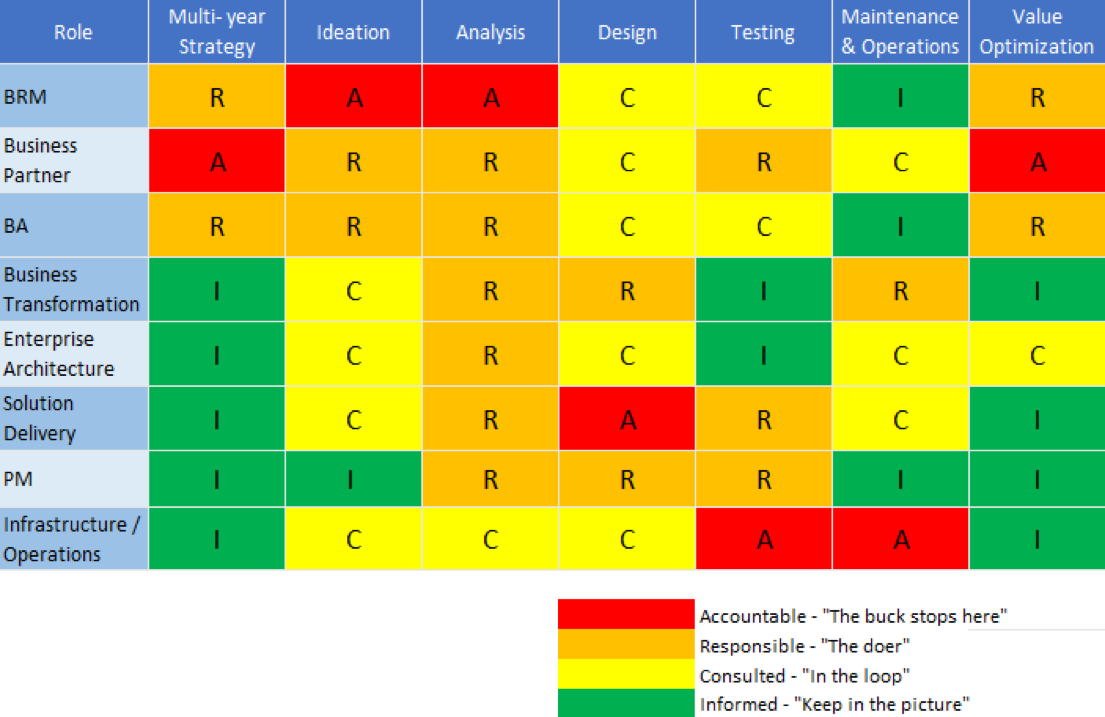Common Pitfalls to Avoid to Ensure BRM Success

When building or rebuilding a BRM capability, avoid these common pitfalls to ensure success.
The scenario: your organization has found itself needing—or in some cases, rebuilding—a BRM capability. Perhaps the need stemmed from the CxO within the business-enabling function (IT, HR, finance, etc.). On the flip side, maybe it was a business partner who expressed the need for the value BRMs bring through strategic partnership after constant frustration around their requests landing in a black hole, or having the feeling that nobody understood their business function.
No matter the reason, there are a few common pitfalls to avoid when building or rebuilding a BRM capability to ensure the success of the BRM as a strategic partner.
Using Business Relationship Managers as a Single Point of Contact
On the surface, using BRMs as a single point of contact might seem like an attractive approach for establishing a relationship and promising a resource to call for everything business partners need. However, the reality is that using BRMs as a single point of contact perpetuates the misconception that they can answer every question posed by anyone in the business function.
Not only does IT have other roles that serve this purpose—such as business capability managers, service desk analysts, business/systems analysts, enterprise architects, and service owners—but using the BRM as a single point of contact results in the BRM failing to keep up with commitments and business support roles waiting for work to funnel into the pipeline while struggling to determine priority. This approach may also shift the business partner’s perception of the role to tactical and could stop them from engaging BRMs in more value-producing activities like shaping business strategy and demand.
Shifting BRMs from process-centric activities to driving strategy and other broader business goals also allows them to focus on growing and transforming the business as a strategic partner, rather than keeping the lights on.
While a core BRM competency is to understand the capabilities of the business function, their role is to connect business partners to the right people who can answer those questions.
Instead, use BRMs as a single point of focus. Allow other roles in the business-enabling function to fulfill and track service requests, provide technical support, and complete other activities needed to “run the business.” BRMs can step in when needed for conflict resolution, negotiation regarding timelines or deliverables, and difficult communications regarding these activities.
Shifting BRMs from process-centric activities to driving strategy and other broader business goals also allows them to focus on growing and transforming the business as a strategic partner, rather than keeping the lights on.
Combining the BRM Role with Other Roles
Some organizations might find that combining a BRM capability with other roles (like project managers or business analysts) is appealing because they are assumed to provide the same level of engagement with business partners. Instead, the absence of role clarity could actually move the BRM’s maturity level down to an order taker or ad hoc state, thereby damaging the relationship.
Although there are some shared skills between certain roles, the focus should be completely different. Project managers should be engaged after ideation, initial value planning, and project approval has been granted. While BRMs should have routine touchpoints with them to ensure that projects are delivered on time and meet the initial business outcomes set forth in the value plan, the actual task of managing those projects should be left to project managers.
Overcoming this challenge will position the BRM to ultimately earn the role of strategic partner, wherein they can provide real business value by driving strategy and sharing ownership for business results.
A RACI chart is a great tool for defining clarity between roles. The Business Relationship Management Body of Knowledge (BRMIBoK) provides a sample RACI chart that can be used for discussions about role definition and creating a chart for your own organization.
Source: Business Relationship Management Institute
No Presence of BRM Champions
Leaders who are routinely in the “Are we working on the right things?” way of thinking should set aside some time to visit with their BRM team. They will quickly find that BRMs are the missing pieces of the strategy puzzle, because they can articulate the goals and objectives that are not only important to business partners but to the entire organization.
This knowledge allows BRMs to shape demand so that business-enabling functions are working on initiatives that provide the most business value and reflect corporate strategy. This is turn helps the business function know they’re working on the right things—at the right time.
With that said, each leader in the business-enabling function should champion for the BRM capability. Doing so will not only expand the level of trust between the business partner and business-enabling organization, but it will result in a less reactive approach to getting work done.
BRMs are the missing pieces of the strategy puzzle, because they can articulate the goals and objectives that are not only important to business partners but to the entire organization.
If getting started proves to be difficult, find a leader who has experienced high business value from the work of BRMs to begin conversations with other leaders.
Tina Pomeroy is a financial services leader with over 25 years of experience in retail banking operations, information technology, business relationship management, business analysis, project management, and process improvement. After building her organization’s BRM capability from the ground up, she now leads the BRM team and is laying the groundwork for becoming a strategic partner with the business. Tina is also a higher education student mentor and a member of the BRM General Council. In her free time, she enjoys spending time with her husband and children, cooking, and volunteering.


Tina – Great article! Definitely a struggle in my organization as well. We find breaking out of the role of tactical BRM is pretty challenging, especially once the Business Partners get used to using the BRM as the single point of contact. Thanks for your insights.
Great article. It is unfortunate that many perceive the BRM as a SPOC. BRM as facilitator is a better mindset, but even then you should be facilitating conversations at a higher level.
Also, I know that the role of “Tactical BRM” is gaining popularity, but that just confuses the role of the BRM. If you are facilitating service delivery of non-strategic types of services and enhancements you are a service delivery manager, development manager, or some other type of operational manager or analyst, and the role is completely different.
It is indeed a great article, I couldn’t put it better myself.
Well said Tina! I especially like the section on the combined roles. Its hard to be effective as a strategic BRM when you are busy also trying to be the BA or the PM in the tactical realm.
There has to be a mistake in the RACI model as only one person can be accountable for every activity. In the analysis section and other columns, more than one role is responsible for a set of activity.
Hi Maria! The intent is to provide a simple visual of who might be accountable, responsible, etc… through the full BRM capability processes used. This chart is to be used for further discussion and customization by your organization, it is not meant as the final chart to use.
In 2017, with the focus shifting from accountability to shared ownership, BRM Institute introduced the ROSCI, a replacement to the RACI, where the A is replaced with an O and other suggested adjustments as follows:
-ensure multi-year strategy (short and long-term) exists (this is business strategy)
-ensure both ideation and value optimization exists
-ensure business partners are identified as a horizontal row.
The ROSCI is not meant to be the final, but a starting point. We are currently working on doing a full revision of this blog post and use the ROSCI in that.
Until then, read more about it here in our Professional Member’s Online Campus: https://campus.brm.institute/display/BRMIBOK/ROSCI+Charting